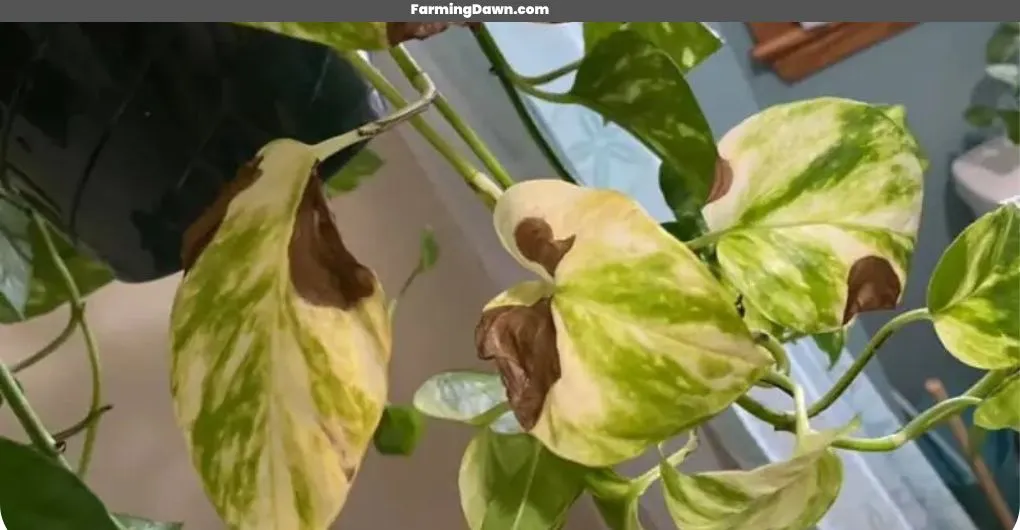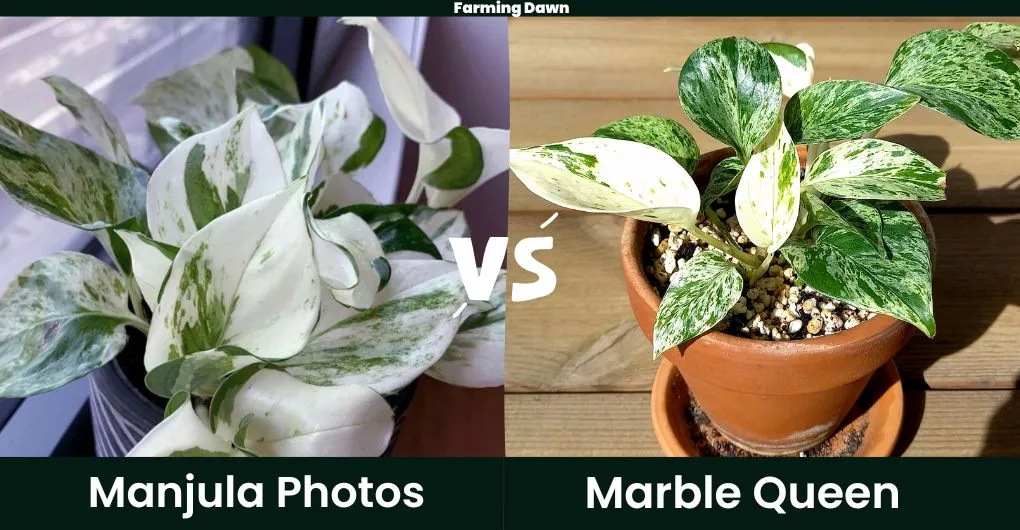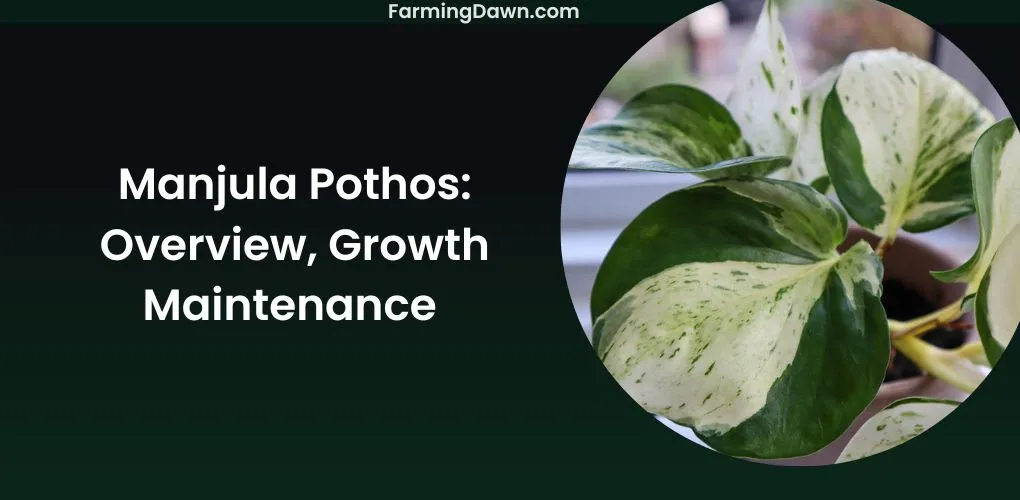Manjula Pothos is one of the most popular houseplants in the world, and it’s no wonder why – with its rich green leaves and cascading vines, it adds a touch of elegance to any space.
It’s also incredibly easy to care for, making it perfect for anyone looking for an effortless way to bring nature indoors. Plus, having this beautiful plant around can help you feel more connected to your home on a subconscious level – that sense of belonging we all crave.
In this post, you will get to know everything you need to know about Manjulas!
What Is Manjula Pothos?
Pothos Manjula, also known as Silver Vine or Scindapsus Pictus, is an attractive and easy-to-care-for houseplant. It is like a magical oasis, with its lush green foliage that cascades down your walls in an enchanting waterfall of greenery.
The unique heart-shaped leaves offer an energizing escape from the everyday world and connect us to nature’s beauty. It’s no wonder why this plant has become so popular amongst all types of people – it offers an emotional respite, a calming presence, and a sense of belonging for those who have embraced it into their homes.
We can all appreciate the way this incredible houseplant brings our lives back into balance and creates harmony within our living space. This is why we love the Manjula Pothos!

Natural Habitat And Origin Of Manjula Pothos
Manjula is a tropical climber native to South East Asia that brings life and color into any home. Its glossy heart-shaped leaves with silver variegation on the edges are truly beautiful!
Manjulas will thrive in bright indirect light but can tolerate low-light situations if necessary. This plant needs moist soil to stay healthy so make sure to water it regularly — just don’t let its roots sit in standing water or else you’ll end up with root rot! With proper care, this unique houseplant can bring a lot of joy!
Characteristics Of The Manjula Pothos
The Manjulas have long been a symbol of grace and beauty, their lush foliage providing an oasis of greenery in any environment.
Its elegant cascading vines make it the perfect choice for hanging baskets or climbing up trellises; no matter how you choose to display this stunning plant, you can be sure that its vibrant green leaves will bring life to any space.
With proper care and maintenance, these plants can live up to 20 years – an impressive lifespan! Their heart-shaped leaves are marked with distinctive yellow variegation, adding further visual appeal and making them highly sought after by those looking for something unique.
The Pothos Manjula is indeed a thing of beauty: easy to grow indoors and offering endless possibilities for decoration.
How To Care For Manjula Pothos?
Taking care of your Manjula Pothos is easy, and you’ll get to enjoy its beauty for many years if you do. I’m gonna give you a few tips so that it can thrive in any environment.
First off, make sure the soil stays moist but not soggy – this will help keep disease at bay and prevent root rot. The plant prefers medium or indirect light, so avoid exposing it to direct sunlight as much as possible.
And don’t forget to fertilize! This helps promote lush growth year-round. Also, prune regularly to remove dead leaves and encourage new growth. With these simple steps, your will stay healthy and happy for years to come!
Common Problems And Solutions
Manjula pothos is a popular houseplant, but caring for it can be tricky. It needs regular pruning and occasional repotting to stay healthy, as well as plenty of indirect sunlight.
Providing manjula with the right environment can be difficult, since too much or too little light, water, or fertilizer can cause stunted growth and browning leaves. Perfectly positioning your plant needs patience and practice; one wrong move could result in unhappy foliage!
But don’t despair – there are plenty of techniques you can use to give your pothos manjula everything it needs to thrive. Keeping track of how often you’re watering, fertilizing, and adjusting its location will help ensure this plant stays alive and vibrant.
Do you know what is vegetation management? Learn to get a better understanding of a healthy plant ecosystem in your garden.
How To Propagate Manjula Pothos?
Now that we’ve looked at common problems and solutions for Manjulas, let’s explore how to propagate them. Propagating this houseplant is a great way to increase your plant collection without spending money!
It’s easier than you may think too. All you need are some scissors or pruners, a few pieces of stem from the existing plants, and soil from your local garden center. Start by cutting off several 4-5 inch long stems with leaves attached.
Make sure each one has at least two nodes – these will be where roots form later on. Then dip the ends of the cuttings into rooting hormone powder before planting them in potting mix. Water lightly every day to keep it moist but not soggy, and within a month or two, you should start seeing new growth emerge!
Also learn: How to propagate string of turtles?

How To Train The Manjula Pothos?
Training the Manjula is no easy feat, but with the right approach and dedication, it can be done. Believe it or not, did you know that according to a recent survey conducted by Plant Virginia Natives, over 75% of people who own this type of plant are able to keep their pothos healthy and thriving?
When training your pothos, there are three essential steps:
- Pruning.
- Staking.
- Tying.
Pruning encourages new growth while removing any dead leaves or stems; think of it as giving your pothos a haircut! Staking provides extra support for taller plants so they don’t droop down in an unappealing way.
And tying helps ensure that your plant grows in its desired shape—whether that’s round and full or tall and slim. With regular attention, patience, and plenty of care these steps can help make sure that your pothos looks amazing for years to come.
So don’t wait—start training today so you can have the beautiful houseplant you’ve always wanted!
Benefits Of The Manjula Pothos
Training Manjulas is no easy task. But the rewards are well worth it! This incredible plant offers a range of benefits that can’t be denied. Aesthetically speaking, they have lush and vibrant foliage with an exotic look to them.
Plus, they’re very low maintenance – perfect for those who don’t have much time on their hands or want something that doesn’t require too much upkeep. They also provide some air-purifying qualities in your home and make great conversation starters when guests come over.
So not only do you get a unique plant for your interior décor, but you also get all these amazing health and environmental advantages as well! In short, if you want something beautiful and practical to add to your living space, then consider investing in a Pothos plant!
Uses For The Manjula Pothos
These plants can remove toxins from the air in your home – how cool is that? The best part about having one of these beauties in your home is getting to watch it grow and thrive as it creates an inviting atmosphere. So why not give it a try? You won’t regret it.
Why Is My Manjula Pothos Leaves Turning Brown?
It’s tough to figure out why the leaves on my Manjula pothos are turning brown. I’m sure you’ve been there – you’re taking care of your plant, but it just doesn’t seem to be working out for some reason.
The thing is, plants can be tricky, and figuring out what exactly is causing this issue isn’t always easy. But don’t worry – with a bit of detective work and patience we can get to the bottom of this mystery!
The first step in solving any problem is understanding how the environment affects your plant. So let’s take a closer look at the light, water, temperature, and soil conditions that could be contributing to our current situation.
After all, if something basic like lighting or watering has gone wrong then these simple fixes may help us turn things around quickly.
On the other hand, if an underlying condition such as disease or pests is affecting your plant then more drastic measures might need to be taken. Either way, once you have a better idea of what’s going on you’ll be able to make informed decisions about how best to move forward with your pothos.
No matter how daunting or confusing things may seem right now, don’t give up hope! With enough research and experimentation, you should eventually discover the cause (or causes) behind those discolored leaves on your beloved houseplant – and soon enough you’ll be back on track toward achieving success with your Manjula plant!

How Much Light Does Manjula Pothos Need?
As far as lighting goes, you’ll be pleased to know that it can thrive in both low and medium levels of sunlight – so there’s no need to put your Manjula in direct sun rays! It does best when placed near a window with indirect sunlight or filtered through sheer curtains.
For optimal growth, keep in mind that too little light won’t do either; make sure the room receives enough natural daylight for your Manjula to get its fill. If you live somewhere where the sun isn’t always shining (like me!), artificial lighting is also an option: just place your plant close by and turn them on for 10-12 hours per day.
How To Identify Manjula Pothos?
Identifying the manjula plant is like searching for the needle in a haystack – it’s almost impossible! But with just a few tips, you can make your search easier. First, look for dark green leaves speckled with yellow or white patches.
The stems of these plants are also usually tinged purple and have an eye-catching variegation along their length. To be sure you’ve found pothos, check to see if the leaf veins are deep green on the underside of each leaf.
Is The Manjula Pothos The Marble Queen?
No, the manjula pothos is not a marble queen. The manjula plant has long waxy leaves that are variegated with yellow and green stripes. Its trailing stems can grow up to 10 feet long in ideal conditions.
On the other hand, the marble queen has round leaves with silver-green markings on top and dark green underneath. It grows short vines of around 3 feet and its foliage stays quite compact. Though both plants come from the same family and share similar care instructions, you can easily tell them apart by their distinct features!
How To Tell Marble Queen Pothos From Manjula?
Believe it or not, there are more than 400 species of pothos plants in the world! Identifying a marble queen pothos from Manjula can seem daunting, but with a few key tips, you’ll be well on your way to distinguishing between them.
Manjulas have rounder leaves that tend to come to a point at their tip and display shades of yellow-green along their edges. Marble queens, however, feature larger teardrop-shaped leaves with white veins running through them for an almost marbled look.
Marble Queen pothos vines will likely grow longer and fuller than Manjula when given proper care. Both types of plant may sport aerial roots which cling onto nearby surfaces so they can absorb moisture – although Manjula’s rootlets are usually much shorter than those found on marble queens.
So go ahead and take a closer look at the image shown below: once you get familiar enough with these two distinct varieties of pothos you’ll never confuse them again!

Where To Buy Manjula Pothos?
Now that you know how to tell a Marble Queen Pothos from Manjula, it’s time to answer the question of where to buy Manjula. It’s important for any plant lover to find a reliable source when searching for plants, so let me share with you my favorite spot: local nurseries!
You can visit your nearest nursery and take home this amazing pothos variety without having to wait for shipping or worry about the condition of the plant once it arrives. Plus, visiting a nursery gives you an opportunity to ask questions and get advice from experienced professionals – something online stores just don’t offer.
And if you’re lucky enough, perhaps even make some new friends who share your love of plants!
How Much Does Manjula Pothos Cost To Buy?
The price of Manjula Pothos typically ranges from $12 to $25, depending on size and availability.
Why Is Manjula Pothos Expensive?
The cost of Manjula pothos is sometimes unbelievable, so much so that it almost feels like you’re buying a piece of art! It’s no secret that plants can make your home look and feel beautiful, but manjula plants takes it to another level with its lush foliage and vibrant colors.
When I think about why these lovely little plants are so expensive, the answer lies in their rarity. They only grow in certain parts of India, making them difficult to come by for anyone outside the region. But if you do manage to find one, the effort will be worth it—as they add an incredible touch of life and beauty to any space!
They require very little maintenance, which makes them even more desirable. So while they may cost a few extra bucks than regular houseplants, when you consider all the benefits they bring into your home, there really isn’t anything else quite like manjula plant on the market.
Frequently Asked Questions Related To Manjula Photos
Are Manjula Pothos Rare?
Manjula pothos is a relatively new and unique cultivar of the pothos plant. While it is not necessarily considered a rare plant, it is still relatively uncommon compared to other pothos varieties such as the golden pothos.
What Is The Difference Between Golden Pothos And Manjula?
Golden pothos and Manjula pothos are both cultivars of the same plant species and share many similarities. However, there are some key differences between the two:
- Leaf color
- Leaf shape
- Growth habit
- Availability
What Is The Rarest Pothos?
There are many different cultivars with unique characteristics, it is difficult to pinpoint the rarest pothos. However, some rare or unusual pothos cultivars include:
- Pothos ‘Jessenia’
- Pothos ‘Njoy’
- Pothos ‘Silver Splash’
- Pothos ‘Cebu Blue
- Pothos ‘Manjula’
Can Manjula Pothos Take Direct Sunlight?
Yes, Manjula plants can tolerate some direct sunlight, but generally, it is best to avoid exposing this plant to prolonged periods of direct sunlight. Direct sunlight can cause the leaves to become scorched and damaged, particularly during the hottest part of the day.
If you do need to place your pothos in an area with direct sunlight, then acclimate the plant slowly by gradually increasing the amount of sunlight it receives. You can also consider placing a sheer curtain between the plant and the window to filter the sunlight and reduce the intensity of the light.
Final Thoughts
The Manjula Pothos is an absolutely stunning houseplant that adds a unique sense of style to any indoor garden. With its easy care and low maintenance needs, the Pothos is perfect for novice plant owners as well as experienced green thumbs!
It’s important to be aware of common problems like browning leaves, so you can take steps to prevent them before they become an issue.
When it comes to purchasing your Manjulas, make sure you do your research and buy from reputable sellers who specialize in this type of plant – otherwise, you may end up with something entirely different! All in all, if cared for properly, my Manjula Pothos will provide me with years of beauty and enjoyment.





